Beneteau Oceanis 30.1
As boat builders clamber to create ever-bigger platforms for ever-more generous budgets, the entry-level cruiser has become an elusive animal. Sure, if you want to daysail, there are plenty of small open boats from which to choose, but if you want a freshly built pocket cruiser, you’re in for a long search. Enter French builder Groupe Beneteau, which identified this gap in the market and set about creating the Oceanis 30.1, an adorable little cruiser that resembles her larger siblings in all but length and price. With all she offers, it wouldn’t be a stretch to call her a mini yacht.
Design & Construction
The hull is by Pascal Conq of Finot-Conq, the firm that ushered in the revamped Oceanis line in 2017 starting with the 51.1. The foam core sandwich hull is svelte at the stem but runs aft into a hard chine just above the waterline. The chine starts just inches aft of the stem and continues all the way back, creating more interior volume throughout.
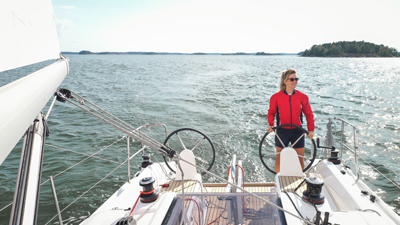
The folding cockpit table leaves ample space to move from the companionway all the way aft to the open transom.
Maximum beam is 9’10” and that allows this boat to be trailered without a wide load permit. The width lends itself to having twin rudders commanded by either a simple tiller or optional twin wheels. There are three choices of keel: a fixed shoal keel at 4’3”, a deep version at 6’2”, or a swing keel for easier beaching and trailering.
Rigging
The tapered, 9/10s, deck-stepped, single-spreader, aluminum mast has an air draft of just under 45 feet. Because there’s no backstay, the spreaders are deeply angled, which means that running off the wind will be a series of shallow jibes rather than sailing with the main let far out. The standard sail area is 425 square feet split between a self-tacking jib and a large square-top mainsail. An in-mast furling main is optional as is an overlapping genoa with jib tracks added to the deck. A rigid vang is standard and there is no traveler.
On Deck
The cockpit is open with twin lifelines running across the transom for safety. A small portion of the transom drops down to form a narrow swim platform, which extends the deck just enough to make water access a bit more comfortable. Outboard of the drop-down section to starboard is a boarding ladder with an added handle to make getting up easier.
Twin wheels are set on slim pedestals and there are integrated footholds to help keep the driver upright when heeling. Winches for the headsail are within easy reach of each wheel. Sheet stoppers and two more winches are on either side of the companionway to manage halyards and reefing lines, which run from the mast on deck.
This is a very traditional winch/line arrangement but there’s nothing old school about the size of this cockpit. Two generous benches straddle a drop-leaf table that will be handy for pleasant al fresco dining. With the leaves down, there’s plenty of room to walk from the companionway all the way back to the water without disturbing those napping on the sides. An optional dodger will keep the whole area dry even with lots of spray.
The starboard bench lifts to reveal deep storage. This ample garage can hold lines, fenders, water toys and even a deflated dinghy. It’s generous stowage space for all things that tend to live on deck.
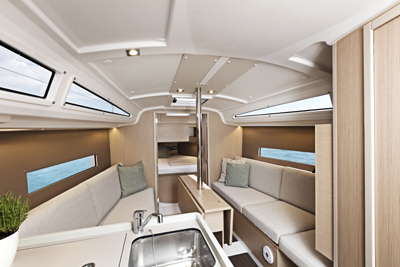 Fixed hull ports bring light to the interior and the open concept elongates the salon so the 30.1 feels like a much bigger boat inside.
Fixed hull ports bring light to the interior and the open concept elongates the salon so the 30.1 feels like a much bigger boat inside.
If there’s any complaint to make about this cockpit, it’s the placement of the electronics. The optional B&G chartplotter is on the starboard bulkhead, which is not only far from the wheels, it can also be obscured by lines coiled and stored on the winch above. The compass just inboard of the plotter seems like an afterthought. One way to make this boat more user friendly would be to add an iPad holder on a suction cup to the pedestals so the driver can have navigation information at her fingertips rather than 10 feet away. You could also add a remote VHF mic to one of the pedestals because radios below aren’t much help when the action is on deck. That can make a world of difference when sailing at night or in fog.
The side decks are acceptably proportioned given the overall beam. At the bow you’ll find the electric windlass below deck, an open pulpit and a bolted-on composite sprit with an anchor roller (angled off to port) with an attachment for a Code 0.
Generous Interior
It’s safe to say that if your dad suddenly found himself inside the Oceanis 30.1, he’d never guess that she’s only 31 feet LOA. Interiors of pocket cruisers of old weren’t known for their spaciousness or their livability and that’s where this design really shines.
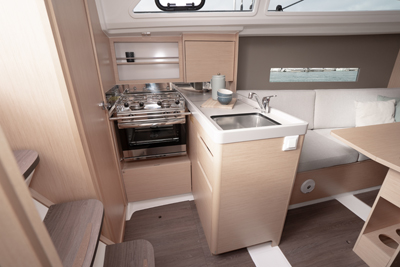 Although compact, the galley has all the tools for a creative cook to serve up full meals so there will be no roughing it on daysails, or while extended cruising.
Although compact, the galley has all the tools for a creative cook to serve up full meals so there will be no roughing it on daysails, or while extended cruising.
The standard (and only) layout includes a master stateroom in the V-berth and a guest cabin aft to port. Both cabins have doors (a split double version for the truncated forward cabin) and both have hanging lockers. The forward bed is wide but somewhat short so taller sailors may opt to sleep aft.
In between is the saloon with a double-leaf table between two straight settees that seat four very comfortably, the L-shaped galley to port and a wet head to starboard that takes up nearly as much space as the galley. For the onboard chef there’s a single sink, a double-burner stove top/oven combination and a top-loading fridge/freezer. It’s a compact galley to be sure but a couple out gunkholing or anchoring for the weekend, should be perfectly comfortable with the arrangement.
In a nod to big boat features, Beneteau even added an aft-facing nav desk with a seat formed by the starboard bench. The electric panel is outboard as is the VHF radio and a Fusion stereo head. The aft bulkhead has plenty of space for cruising guides, navigation tools, books and magazines.
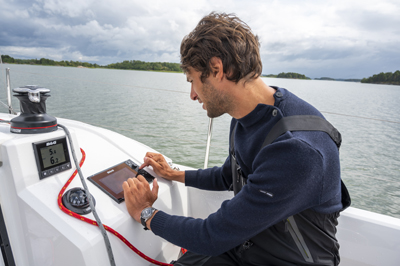 The MFD is integrated into the starboard bulkhead and that keeps the helms more streamlined for the driver.
The MFD is integrated into the starboard bulkhead and that keeps the helms more streamlined for the driver.
For such a compact vessel, Beneteau managed to slide in a friendly companionway entrance. Three gently sloped steps lead below so the ladder entrances of yore are blissfully gone. Two overhead hatches ensure good ventilation and fixed hull windows as well as the use of light Alpi white oak joinery and a white headliner make the boat bright and pleasant as opposed to cave-like. Headroom is an impressive 6’ 1” – 6’ 3”. Nice touches include automatic locker lighting and USB ports, which your dad wouldn’t even recognize.
Under Sail
With a D/L ratio of 171, the Oceanis 30.1 is considered a light displacement design and that’s perfect for everyday sailors who often struggle with fleeting breezes. The real power behind this rig is the square top mainsail that takes advantage of there being no backstay and that’s the way to go over an in-mast main. Instead of the optional overlapping genoa, a more versatile sail plan would include the self-tacking jib and a Code 0 for downwind sailing. With that setup, this slippery little boat can be singlehanded and given that she displaces well under 10,000 pounds, she’ll be moving in light winds when others are forced to motor.
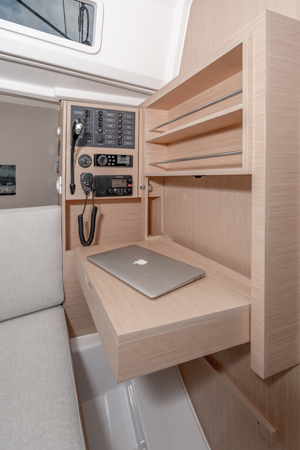 It’s nice to have a dedicated space for ship’s business at the aft facing nav desk that shares a seat with the starboard settee.
It’s nice to have a dedicated space for ship’s business at the aft facing nav desk that shares a seat with the starboard settee.
The Oceanis 30.1 carries a category B rating, which makes her good for coastal hopping. Although there will be those who will club race, her real comfort zone will be as a near-shore explorer for a couple with occasional guests or a small family.
Under Power
Two options of propulsion are offered. The standard is a Yanmar 14 hp engine accessible below the companionway steps. With this engine, the boat is approved for inland waterway navigation only. An upgrade to 21 hp is available to make her coastal and both engine choices come with a straight shaft. Although this is a light boat, it’s always better to have extra power, especially when going into head seas, so the upgrade to the larger diesel should be on any buyer’s list. Choosing a folding two-blade propeller will ease drag when sailing.
Sightlines are good from both wheels and the boat is responsive in tight quarters. The engine controls are at knee level on the starboard side and although that’s not the ideal position for the throttle when docking, it’s workable.
Overall Thoughts
Beneteau offers this design in a fairly comprehensive package with their basic trim level and electronics pack. Additional options include teak decking in the cockpit, a pearl grey hull color, the twin wheels and upsized engine, and the shallow draft keel versions. Well equipped, you can expect to pay under $180,000.
Just as everyone is focused on the top end where long hulls dominate, this little design has been racking up awards as well as finding a target market ready for something special. The Oceanis 30.1 is a small boat with a big heart and she has great amenities to match. She’s a little big yacht and if anyone tells you she’s too small for “yacht” status, just invite them aboard.
Specifications
LOA: 31′ 3″
Beam: 9′ 10″
Draft: 4’3”, 6’2”
Displacement: 8,805 lbs.
Sail Area: 425 sq. ft.
Air Draft: 44, 10”
Fuel/Water: 34/42 gallons
Engine: Yanmar 14 or 21 hp
Designer: Pascal Conq
Builder: Groupe Beneteau
As tested price: USD $156,911 retail before commissioning.






















